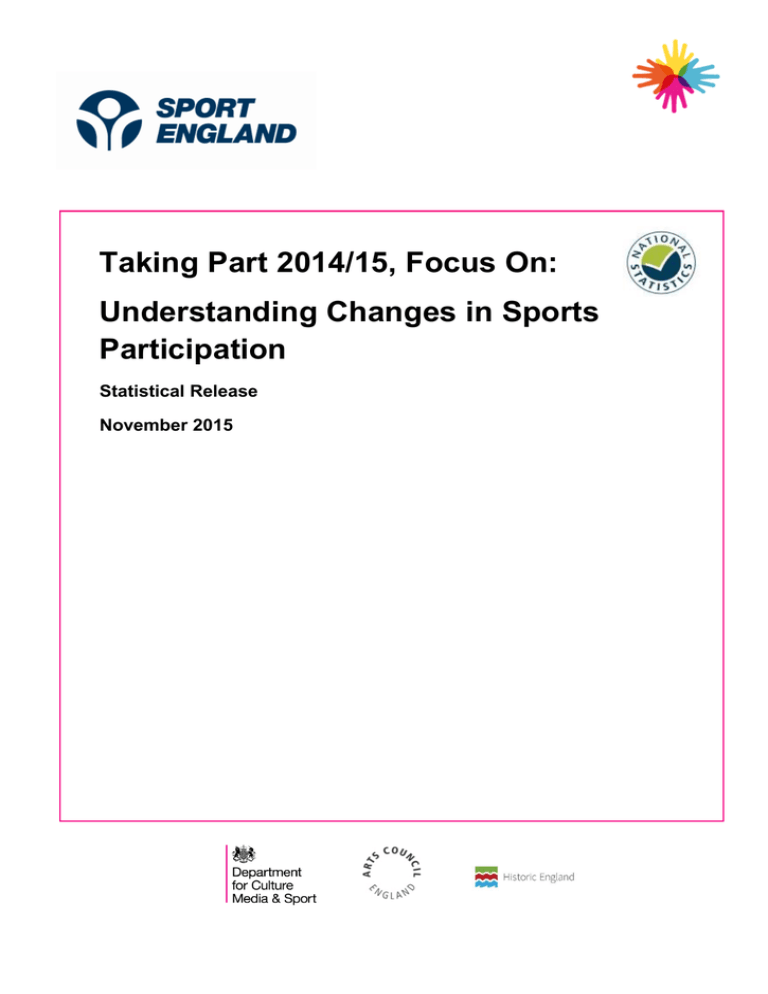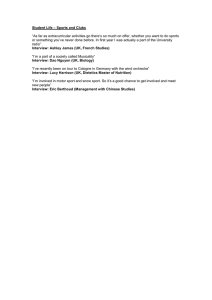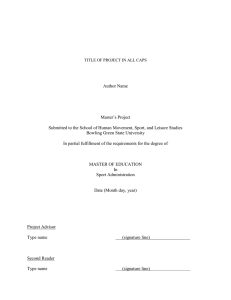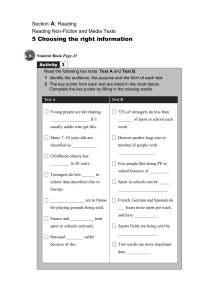Taking Part 2014/15, Focus On: Understanding Changes in
advertisement

Taking Part 2014/15, Focus On: Understanding Changes in Sports Participation Statistical Release November 2015 2 Department for Culture, Media and Sport Taking Part – Statistical Release Introduction This report This report is one in a series of ten “Taking Part, Focus On” reports, presenting findings on the tenth year of the Taking Part survey (2014/15). Taking Part is a continuous face to face household survey of adults aged 16 years and over and children aged 5 to 15 years old in England. The series expands on and complements the Statistical Release published on 25th June 2015 that presented headline adult findings from the survey, covering April 2014 to March 2015. The “Focus On” series looks in more detail at specific topics, with each report covering one of the following areas: 1) Art forms 2) Sport 3) Heritage 4) Free time activities 5) Barriers to participation, disability 6) Society 7) Wellbeing 8) Digital engagement 9) Newspaper readership 10) First World War Centenary This report focusses on how sports participation changes for an individual over time and some of the factors that influence this. There is a specific focus on the impact of life events such as someone’s children starting school and the role different sports play. Forthcoming releases The next adult release, to be published on Thursday 17 th December, will present data covering the period October 2014 – September 2015. Future adult releases of Taking Part will be published every six months. The next biannual release is therefore scheduled for July 2016 and will present data covering the period April 2015 – March 2016. Future adult releases will follow a similar schedule, being released every six months in July and December. In addition, another series of “Taking Part, Focus on…” reports will be published in April 2016. Like the current report, each ‘short story’ in this series will look at a specific topic in more detail, providing more in-depth analysis of the 2014/15 Taking Part data than seen in the biannual report. If you would like further information on these releases or the Taking Part survey, please contact the Taking Part team on TakingPart@culture.gov.uk. Department for Culture, Media and Sport Taking Part – Statistical Release Headline Findings What have we learnt from this research? Whilst the overall number of people playing sport is fairly stable, there can be quite dramatic changes to the amount and type of sport individuals take part in. People don’t have a single sporting habit and, like any consumer, their needs change over time. Some activities appear better than others at retaining the people who take part in them. Life events, like moving house or having children, can influence the amount of sport played by adults. The scale and nature of these changes differs by life event. The vast majority of adults who have recently taken up sport are not completely new to sport: they bring some kind of sporting experience or knowledge when they take up a new activity (usually relatively recent). Attendance at: 3 Department for Culture, Media and Sport 4 Taking Part – Statistical Release Chapter 1: Changes in Participation Taking Part asks all adult respondents whether they have participated in any sport or physical activity over the previous four weeks. People in the longitudinal survey (those who complete the Taking Part questionnaire in multiple years) are asked the same question again at their second interview a year later and by comparing their different answers across years, we can start to build a picture of changes over time. First interviews were conducted across years 7 and 8 of the Taking Part survey (2011/12 and 2012/13) and second interviews across years 8 and 9 (2012/13 and 2013/14). What do we count as sport? Eligible activities include: Swimming BMX, cyclo-cross or mountain biking Cycling for health, recreation, training or competition Bowls Tenpin bowling Health, fitness, gym or conditioning activities Keepfit, aerobics or dance exercise Judo Karate Taekwondo Other martial arts such as tai chi Weight training Weightlifting Gymnastics Snooker, pool or billiards Darts Rugby League Football Hockey Gaelic sports Cricket Rugby Union American football Archery Baseball or softball Netball Tennis Badminton Squash Basketball Table tennis Track and field athletics Jogging, cross-country or road running Angling or fishing Yachting or dinghy sailing Canoeing Windsurfing or boardsailing Ice skating Curling Golf Skiing Horse riding Climbing or mountaineering Hill trekking or backpacking Motor sports Shooting Volleyball Orienteering Rounders Rowing Triathlon Boxing Waterskiing Lacrosse Yoga Fencing Croquet Pilates Frisbee Trampolining Rambling Any other water sport Skittles Department for Culture, Media and Sport Taking Part – Statistical Release 5 Levels of overall participation are relatively consistent Overall, the amount of sport people played varied very little from first to second interview, regardless of whether they’re normally active 1-3 times a month, 4-11 times a month or more than 12 times a month (Figure 1.1). Figure 1.1: Monthly participation in sport (a session = at least 30 minutes, moderate intensity) at interview 1 vs. interview 2 What is a confidence interval? 25 It’s impossible to ask every single person in Percentage 20 the population how much sport they play. That’s why this research is carried out with a 15 representative sample of the population. A ‘confidence interval’ is the range in which there 10 is a specific probability that the true value will 5 lie within. For this survey, 95% confidence intervals are used which means, had the 0 sampling been conducted 100 times, creating 1-3 sessions 4-11 sessions Interview 1 12+ sessions Interview 2 100 confidence intervals, then 95 percent of these intervals would contain the true value. Notes (1) Confidence intervals range between +/-0.7 and +/-1.0. At an individual level, we also see that participation remains relatively constant over time with three-quarters of people either doing some sport, or not doing any sport, at both interviews. (Figure 1.2). Figure 1.2: Participation in sport at first and second interviews as a A third of people took part consistently in at least some Attendance at: share of the population sport at both their first and second interviews. A slightly smaller proportion (25 per cent) took part weekly at both interviews 43 per cent of people did no sport at either interview Sport at both interviews 33% Nothing at either interview 43% Of the remaining quarter, 12 per cent took part at just their first interview and 12 per cent at just their second interview Sport 1st interview only 12% Sport 2nd interview only 12% Department for Culture, Media and Sport 6 Taking Part – Statistical Release Participation patterns are less consistent Whilst overall participation levels did not change significantly over time, analysis of those who were active at their first interview shows that only 36 per cent of these participants took part in the same amount of sport at their second interview. The remaining two-thirds have changed their participation patterns. A quarter were not participating at their second interview, leaving 38 per cent who have either increased (20 per cent) or decreased (18 per cent) the amount of sport they do. (Figure 1.3). Figure 1.3: Profile of sport participation for those doing some sport at their first interview What do we mean by ‘same amount of for their second interview sport’? 45 If someone takes part in 1-3 sessions a month at their Percentage 40 first interview and still takes part in 1-3 sessions of 35 sport at their second interview, we say that they have 30 done the same amount. Similarly if they do 4-7 25 sessions at both interviews, 8-11 sessions at both, or 20 12+ 15 participated the same amount. sessions at both interviews they have 10 5 Males are more likely to have done the same 0 Same Stopped More Less Notes (1) Confidence intervals range between +/-1.5% and +/-1.9%. amount of sport whilst females are more likely to have stopped participating. Does frequency of participation impact on the likelihood of a person staying active? There is no pattern to the number of sessions someone did at interview two having been inactive at interview one. It is as likely that someone would play sport three times a week or more (12+ sessions) as taking part infrequently (1-3 sessions a month). This challenges the idea that it is usual for inactive individuals to increase gradually their activity levels. It appears just as likely that an individual will go from not participating to very frequent participation in a short space of time. This group is explored in more detail in Chapter 3. We do however find that consistency is highest amongst those participating the most. Individuals participating three times a week or more (12+ sessions) at their first interview are by far the most likely to still be at that level come their second interview. Those who take part once or twice a week are more likely to participate more often than at their first interview. Infrequent participants are most likely to not be participating at the time of their second interview (Figure 1.4). Department for Culture, Media and Sport 7 Taking Part – Statistical Release People who played the least sport at first Figure 1.4: Profile of sport participation at second interview are the most likely to stop by the time interview by level of participation at first interview of their second interview (44 per cent). They are also the most likely group to do more sport (37 Percentage per cent) A very different picture is true of the most active people – where they are most likely to continue the same amount of activity (58 per cent), but also most likely to do less (27 per cent). They 100 90 80 70 60 50 40 30 20 10 0 are least likely to have stopped altogether. 30 27 15 21 33 29 44 15 27 37 58 19 23 23 1-3 sessions 4-7 sessions 8-11 sessions Same More Less 12+ sessions Stopped How does consistency of participation differ by sport? People taking part in bowls had the most consistent participation rates across interviews, with 43 per cent taking part How are we defining who has taken part in a weekly at both interviews. This is followed by sport? fitness activities with a third of participants If someone has done one or more sessions in the last 28 doing them weekly at both interviews and days of a given sport at either their first or their second football at 29 per cent. Racket sports and interview they are included as a participant in that sport. swimming have the lowest consistency level for weekly participation (Figure 1.5). Figure 1.5: Proportion of participants by sport who took part weekly at both interviews Racket Sports Swimming Cycling Team (minus Football) Golf Running Football Keepfit, Yoga, Pilates, Weight Training, Weightlifting Bowls 0 10 20 30 Percentage Notes (1) Confidence intervals range between +/-1.9% and +/-9.8. 40 50 60 Department for Culture, Media and Sport 8 Taking Part – Statistical Release Case study 1: Fitness Activities People taking part in fitness activities tend to show more consistent behaviour across interviews, with a third participating weekly at both interviews. 60 50 interview: 40 Only 9 per cent moved either up from 1-3 sessions per month to once a week or down from once a week to 1-3 sessions per months 30 20 10 41 per cent stopped participating between their first and second interviews Percentage Of those taking part in fitness activities at their first Half continued at the same level of participation. For nearly all of these, this was weekly participation. 0 Same Stopped More Less Notes (1) Confidence intervals range between +/-1.1% and +/-2.9%. Furthermore, those doing fitness activity at their second interview who did not do so at their first interview are likely to have been active in something else at their first interview, with 45 per cent doing a different sport and 40 per cent walking. Despite this, 15 per cent were completely inactive at interview one. This is comparatively high compared to other sports. For those dropping out of fitness activity at their second interview, we find that a similar amount (44 per cent) continue on to a different sport. Interestingly, most of these already did that sport alongside fitness at their first interview. People who play football exhibit very similar behaviours to those outlined for fitness participants above, except that they are more likely to take part in another activity before starting football. Similarly, they are more likely to remain active after they stop playing football. Department for Culture, Media and Sport Taking Part – Statistical Release Case study 2: Swimming People taking part in swimming tend to have more inconsistent behaviours with just 12 per cent participating weekly at both interview. 70 Of those taking part in swimming at their first interview: Only 14 per cent moved either up from 1-3 sessions per month to once a week or down from once a week to 1-3 sessions per month 50 Percentage 60 40 30 56 per cent stopped participating between their first 20 and second interviews 10 Just under a third continued at the same level of swimming participation, this is split 2/3rd weekly to 1/3rd less than weekly 0 Same Stopped More Less Notes (1) Confidence intervals range between +/-1.7% and +/-3.7%. Those taking up swimming at their second interview are more likely to have been active already at their first interview than not, with half doing a different sport and 41 per cent walking. Less than 10 per cent were inactive. For those dropping out of swimming at their second interview, we similarly find that half continue on to a different sport. Again, most of these already did that sport alongside swimming at their first interview. Cycling and racket sports participants exhibit very similar properties to those outlined for swimming. However, it is more likely someone will do a different sport at interview one before picking up cycling. It is also more likely someone will continue to a different sport at interview two, having taken part in racket sports at interview 1. Running participation is also relatively inconsistent but poses an interesting variation to the swimming model. The inconsistent behaviours exhibited are somewhat surprising given the steady upward trend in participation. We assume the popularity of starting running brings in more people than it loses. As per participants in racket sports, runners are more likely to continue with a different sport when stopping running: this activity tends to be fitness. 9 Department for Culture, Media and Sport 10 Taking Part – Statistical Release Chapter 2: Impact of Life events Survey respondents were asked at their second interview whether they had experienced any changes in their lives. Analysis of these changes alongside participation data gives us a picture of how people move in and out of sport and which factors have a positive and negative influence on their levels of activity. What do we count as a life event change? Moving house Having significantly more disposable income Having significantly less disposable income Significant increase in financial commitments such as household bills, mortgage, loans etc. Major financial crisis, like losing the equivalent of 3 months income Leaving school or university Work demands increasing Changing jobs (respondent or partner) Losing their job (partner losing their job) Retiring (respondent or partner) Getting a pet Pet dying or becoming ill Starting a new relationship Moving in with a partner Getting engaged or married Having a first child Having another child Children starting school Children leaving home Serious illness or injury Someone in their immediate family becoming seriously ill Taking on additional caring responsibilities for a friend or family member Separation due to divorce, marital difficulties or relationship breakdown Death of a spouse Death of a close friend Death of a close family member Department for Culture, Media and Sport 11 Taking Part – Statistical Release Some life events have more of an impact on participation than others Analysis of adult participation changes across the two interviews shows that children starting school, starting a new relationship and separation from a partner are most associated with people playing more sport. In contrast, moving house and children leaving home have a negative impact. (Figure 2.1). Figure 2.1: Change in participation from interview 1 to interview 2 by life event Moved house Children left home You [or your partner] changed jobs You [or your partner] retired Work demands increased Serious illness or injury Left school or university You [or your partner] lost your [their] job Had first/another child Significantly more disposable income Got a pet Death of close friend/family member Major financial crisis Significantly less disposable income Taken on additional caring responsibilities Someone in your immediate family became seriously ill Significant increase in financial commitments Pet died/became ill Got engaged/married Seperation (divorce etc) Started a new relationship Child started school Significant changes since interview 1: No change Increase Decrease -15 -10 -5 0 5 10 15 Percentage Notes (1) Confidence intervals range between +/-0.6% and +/-4.0%. Some factors have more or less impact, depending on gender. These are outlined below: Leaving school or university has a negative impact on males (-7 per cent) but a positive impact on females (+3 per cent) Starting a new relationship has a much greater positive impact on females (+16 per cent) than on males (+4 per cent) Moving house has a greater negative impact on males (-15 per cent) than on females (-3 per cent) When looking at the life event changes in more detail, we note that negative impacts on participation do not necessarily mean stopping sport altogether. It can also mean a reduction in the amount of activity. The rest of this chapter explores some of these events in more detail. 12 Department for Culture, Media and Sport Taking Part – Statistical Release The impact of moving house Moving house has a negative impact on weekly participation with rates decreasing nine percentage points for this group compared to their first interview (prior to moving home). Despite this, we see a significant group of people doing more sport than they did at their first interview. Looking deeper at the data, we see that the active (already participating at least once a week) become more active, whilst the impact on those doing less is to drop below the weekly threshold. Importantly, moving home does not appear to lead to increased drop out. (Figure 2.2). Moving house does not increase the likelihood that someone will stop participating in sport. Figure 2.2: Impact of moving house on level of weekly sports participation People are more likely to participate more than remain at the same level. Two-thirds of those doing more sport were already participating once a week, this is in line with participation changes overall. Indications are that a greater share of those participating less fall beneath the once a week threshold as compared to participation overall. Notes (1) Confidence intervals range between +/-5.5% and +/-7.0% (2) Overall blue dots show the proportion in each group for all people in the sample. Department for Culture, Media and Sport Taking Part – Statistical Release 13 The impact of changing jobs Changing jobs has a smaller negative impact on weekly participation rates (-3 per cent) than moving house and appears to impact in a different way. Changing jobs makes it much less likely that someone will do more sport. They are more likely to maintain current levels or stop participating. It is the combination of these factors that leads to the overall negative impact. (Figure 2.3). Figure 2.3: Impact of changing jobs on participation Changing jobs increases the likelihood that someone will stop participating. People are more likely to remain at the same level than participate more. People are unlikely to do more sport. Two-thirds of those participating less still continue to meet the once a week threshold. Notes (1) Confidence intervals range between +/-2.3% and +/-6.1% (2) Overall shows the proportion in each group for all people in the sample. The impact of children starting school Children starting school has the largest positive impact on weekly adult participation overall (12 per cent increase). Adults in this group are more likely to do more sport than previously, but they are also more likely to stop participating. The main driver for the increase in participation is in fact because people are twice as likely to start sport after their children start school (24 per cent population versus 12 per cent average). (Figure 2.4). Figure 2.4: Impact of children starting school on participation 50 parents will stop participating. 40 People are more likely to participate more and less likely to remain at the same level of participation. Percentage Children starting school increases the likelihood that 30 20 10 People are twice as likely to take up sport after their children start school. 0 Children started school Overall New at interview 2 Stopped at interview 2 Participated at both interviews Participated at neither interview Notes (1) Confidence intervals range between +/-4.0% and +/-5.7% 14 Department for Culture, Media and Sport Taking Part – Statistical Release The impact of separating from a partner Separation from a partner leads to adults doing more sport compared to their first interview with the weekly rate increasing by 9 percentage points. Unlike when children start school, this isn’t achieved by people starting to do sport but through people increasing the amount of sport that they do alongside very few people stopping taking part. Figure 2.5. Figure 2.5: Impact of separating from a partner Separation from a partner reduces the likelihood on participation that someone will stop participating. Nearly three-quarters of people do more sport leaving far fewer stopping and very few doing less. Of those doing more sport, the proportion that already met the once a week threshold is consistent with overall participation changes. Notes (1) Confidence intervals range between +/-3.7% and +/8.1% (2) Overall blue dots show the proportion in each group for all people in the sample. A very similar pattern is observed for adults starting a new relationship. Department for Culture, Media and Sport Taking Part – Statistical Release 15 Chapter 3: Previous engagement in sport In chapter 1, we learned that there is no pattern to the number of sessions of sport someone did at interview two having been inactive Figure 3.1: Frequency of participation at interview two for those not participating at interview one at interview one. It is as likely that someone will start doing sport very frequently and infrequently. (Figure 3.1). 12+ sessions 24% 1-3 sessions 33% This group of participants are explored in more detail in this chapter, particularly looking at whether they are 4-11 sessions 43% “recent participants” or “returners to sport” and what, if any, impact this has. In order to understand previous engagement with sport, participation rates in the previous year were analysed. This found that, whilst they had not been active in the previous month at interview one, almost 80 per cent of “new” participants had taken part in sport at some point in the past year. This suggests that the majority of people have had some relationship with sport in the previous 12 months. With only two interviews worth of data we are unable to make firm judgements about the proportions who are new to sport versus those returning. Therefore, for the purpose of this report, we have approximated three pathways to eventual participation at interview 2. 16 Department for Culture, Media and Sport Taking Part – Statistical Release The three pathways into sport at interview two (Figure 3.2) Pathway 1 (Recent participants): Sport in the last 12 months at interview 1 Pathway 2 (Returning participants): No sport in the last 12 months at interview 1, but active at some point prior Pathway 3 (New participants): No sport in the last 12 months, or at any point prior Pathway 1 Pathway 2 Returning participants Recent participants 80% 14% Pathway 3 New participants 6% Sport at Interview 2 Figure 3.3: Level of sports participation at We have analysed whether the different interview two by pathway into sport pathways affect the amount of sport 100 undertaken, but there appears to be very little 90 they do. (Figure 3.3). Percentage difference. This indicates that the route into sport does not impact onto the level of sport 24 26 43 43 33 31 Recent participants Returning participants 80 70 60 50 40 30 20 10 0 1-3 sessions 4-11 sessions 12+ sessions Department for Culture, Media and Sport Taking Part – Statistical Release 17 Which sports are people more likely to pick up? Where it was possible, we have analysed which sports people take part in, depending upon which pathway they have come through. Figure 3.4: Participation by sport for those who We find that for our recent participants, fitness are recent participants (participated in the last activities remain the most popular sport with 12 months at interview one) remains high in cycling (two-thirds), swimming (just over half) and racket sports (just under half). For swimming, however, we see a greater skew towards people being returners to swimming, whilst for cycling we see a skew towards them being new to cycling, just not new to sport (Figure 3.5). Percentage almost three-quarters taking part. Participation 90 80 70 60 50 40 30 20 10 0 Keepfit, Yoga, Pilates, Weight Training, Weightlifting Cycling New to that Sport Swimming Racket sports Return to that Sport Notes (1) Confidence intervals range between +/-3.6% and +/-4.2% Figure 3.5: Participation by sport for those who are new to sport (did not participate in the last 12 months at interview one) Percentage Overall 70 60 50 40 30 20 10 0 Keepfit, Swimming Yoga, Pilates, Weight Training, Weightlifting Cycling Racket sports For those who are returning participants, again fitness activity remains the sport they are most likely to do. Their participation rate matches the overall participation rate for fitness at interview two, suggesting it is accessible for this group. Swimming is the second most popular activity with a quarter taking part, but this is below the overall swimming participation share. (Figure 3.4). Notes (1) Confidence intervals range between +/-3.5% and +/-8.1% (2) Overall blue dots show the proportion participating in each sport for all people in the sample. Overall, recent participants (those that had participated in the last 12 months at interview one) are more likely to take part in a range of activities than those who had not participated in the last 12 months at interview 1 (returning participants). 18 Department for Culture, Media and Sport Taking Part – Statistical Release Annex A: Further details 1. The Taking Part survey is commissioned by the Department for Culture, Media and Sport (DCMS) and its partner Arm’s Length Bodies (ALBs). For 2011 to 2015 these are Arts Council England, Historic England and Sport England. 2. Taking Part is a National Statistic and as such has been produced to the high professional standards set out in the Code of Practice for Official Statistics. National Statistics undergo regular quality assurance reviews to ensure they meet customer needs and are produced free from any political interference. See the Statistics Authority code of practice for more information. The UK Statistics Authority has designated these statistics as National Statistics, in accordance with the Statistics and Registration Service Act 2007 and signifying compliance with the Code of Practice for Official Statistics. Designation can be broadly interpreted to mean that the statistics: • meet identified user needs; • are well explained and readily accessible; • are produced according to sound methods; and • are managed impartially and objectively in the public interest. Once statistics have been designated as National Statistics it is a statutory requirement that the Code of Practice shall continue to be observed. See the UK Statistics Authority assessment for more information. 3. The latest results presented here are based on interviews issued between April 2014 and March 2015. The total sample size for this period is 9,817. 4. Statistical significance tests have been run at the 95% level. A significant increase at the 95% level means that there is less than 5% (1 in 20) chance that the difference observed within the sampled respondents was not also observed in the English population as a whole. 5. For more information see the Taking Part Survey webpages, including previous publications. Versions of the questionnaires from all years of the survey are also available. 6. The fieldwork for the survey has been conducted by TNS-BMRB. For more information, see http://www.tns-bmrb.co.uk. 7. The series of reports has been produced by Helen Miller-Bakewell, Wilma Deda, Becky Woods, Catherine Mottram and Niall Goulding (DCMS), Louise O’Sullivan, David Bade and Adala Leeson (Historic England), Eloise Poole (Arts Council England), Rachael Whitney and Helen Price (Sport England). Acknowledgement goes to colleagues within the DCMS, partner ALBs and TNS-BMRB for their assistance with the production and quality assurance of this release. 8. The responsible statistician for this release is Helen Miller-Bakewell. For enquiries on this release, please contact Helen on 0207 211 6355. This release was prepared by Rachael Whitney and Helen Price. 9. For general enquiries telephone: 0207 211 6200 or email enquiries@culture.gov.uk. 10. To be kept informed about Taking Part publications and user events, please sing up to the Taking Part online newsletter here. Department for Culture, Media and Sport Taking Part – Statistical Release 19 © Crown copyright 2015 You may re-use this information (not including logos) free of charge in any format or medium, under the terms of the Open Government Licence. To view this licence, visit www.nationalarchives.gov.uk/doc/open-government-licence/ or write to the Information Policy Team, The National Archives, Kew, London TW9 4DU, or email: psi@nationalarchives.gsi.gov.uk





